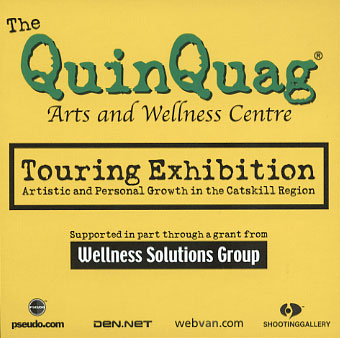
Michael Smith and Joshua White
The Quinquag Arts and Wellness Centre Touring Exhibition:Artistic and Personal Growth in the Catskills Region
November 9 - December 30, 2001
In their third collaborative project, Michael Smith and Joshua White present The QuinQuag Arts and Wellness Centre Touring Exhibition: Artistic and Personal Growth in the Catskills Region (2001), an elaborate narrative installation. Visitors enter (the gallery) occupied by what is ostensibly a traveling exhibition featuring photographs, craft objects, artworks, and a video presentation. Didactic wall panels relate the history of QuinQuag, an art colony created in 1950 in upstate New York with a generous donation of land by founder Isabelle Nash. As part of the QuinQuag charter, residents not only make their own art, they produce and sell craft objects - from hand painted tiles to rocking chairs - to maintain a (symbolic) appearance of being self-sustaining.
Unaware of the colony's existence, entrepreneur "Mike Smith" buys the property in 1999, ten years after the founder's death. When his performance artist girlfriend learns about QuinQuag and discovers that QuinQuag tiles have become collector's items, Mike elaborates on his original plan so that he can cash in on the colony's cultural cachet. The result is a traveling exhibition to promote their new concept: the QuinQuag International Wellness and performing Arts Centre.
Using a hybrid, documentary-style format, Smith and White's QuinQuag installation immerses the viewer in a complete and utterly credible fictional world, complete with a complex back story and an up-to-the-minute tale of failing investments and doomed attempts to marry commerce and art. With elements familiar from news stories as well as from recent cultural history, it all seems plausible enough to make us think twice about the ways "high" culture is regularly employed as a sales tool to add luster to property developments or to help package lifestyle trends.
In addition, the work's peculiar realism - including the display of ersatz historical artifacts and footage from a fabricated television documentary- serves to underscore the conundrum of installing a fictitious exhibition within an actual one. Smith and White imply that both endeavors are, if not equally fabulous in nature, at least similarly contingent. Indeed, inasmuch as their work calls attention to the practice of exhibition making, it does so to reveal its shared links with commercial display and the art of salesmanship.
Smith and White's installation also touches on the theme of survival. Absorbing this droll tale of misguided ambitions, we are left to wonder about the fate of the QuinQuag colony's resident artists, whose future seems utterly precarious. Of course, so is the future of most working artists, who possess virtually no safety net, no job-provided health insurance or pension plans. With blank-faced irony, Smith and White's semi-utopian fiction of a self-supporting artist's colony only serves to call attention to this fact. And in apparently condemning their remote colony to failure, Smith and White seemingly suggest that we can constructively reinvent the artist's world not be looking to isolate it but by re-envisaging the lines of connection that link it to the surrounding culture.